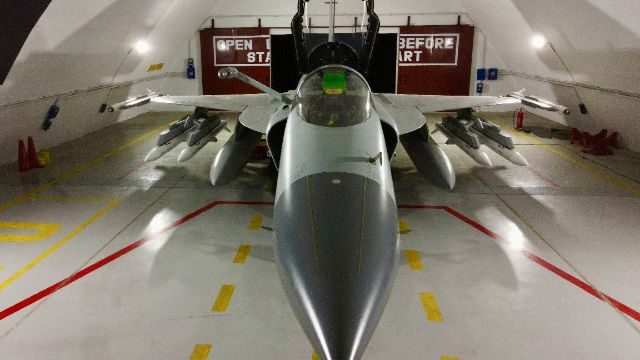Pakistan Arms JF-17 Thunder with China’s Deadly PL-15 Missiles Amidst Kashmir Crisis
Reports emerging from regional defence sources confirm that China has expedited deliveries of the potent PL-15 missiles to Pakistan, a move strategically timed to enable Islamabad to counter India’s formidable fleet of advanced combat jets, notably the Rafale and Su-30MKI.
(DEFENCE SECURITY ASIA) – With tensions between nuclear-armed rivals Pakistan and India escalating dangerously following the devastating incident in Pahalgam, Jammu and Kashmir, resulting in 26 fatalities, Pakistan’s military has strategically unveiled images of its JF-17 Thunder fighter jets equipped for the first time with China’s advanced long-range PL-15 air-to-air missiles.
The images, disseminated through STRATCOM Bureau on social media platform X, also prominently featured JF-17 fighters armed with China’s sophisticated short-range PL-10 air-to-air missiles, underscoring a substantial leap in Pakistan’s aerial combat capabilities.
Reports emerging from regional defence sources confirm that China has expedited deliveries of the potent PL-15 missiles to Pakistan, a move strategically timed to enable Islamabad to counter India’s formidable fleet of advanced combat jets, notably the Rafale and Su-30MKI.
This accelerated military transfer by Beijing represents a clear signal of China’s deepening commitment to Pakistan amidst intensifying Indo-Pakistani hostilities, dramatically reshaping the geopolitical balance within the South Asian security landscape.
The PL-15 missile, capable of reaching speeds approaching Mach 4, integrates an advanced Active Electronically Scanned Array (AESA) radar system, optimised specifically for beyond-visual-range (BVR) combat engagements, thus significantly expanding Pakistan’s aerial deterrent capabilities.
Crafted meticulously by China’s prestigious Academy of Launch Vehicle Technology (CALT), the PL-15 is recognized globally as one of the most advanced BVR missile systems currently in service, drawing direct comparisons to the renowned American AIM-120D AMRAAM and Europe’s METEOR missile.
With an operational reach surpassing 300 kilometers, the PL-15 missile provides Pakistan with one of the longest-range air-to-air strike capabilities worldwide, critically enhancing its strategic and tactical air operations.

Military analysts stress that the integration of the PL-15 into Pakistan’s JF-17 arsenal fundamentally alters the tactical calculus of aerial engagements, enabling Pakistan Air Force (PAF) pilots to target and neutralize enemy aircraft from unprecedented distances, thus increasing operational survivability and effectiveness.
Such a sophisticated upgrade presents significant challenges to the Indian Air Force (IAF), forcing crucial adjustments to combat tactics and strategic planning involving frontline aircraft like the Su-30MKI, Rafale, and Mirage 2000, potentially redefining the dynamics of regional air superiority.
The advanced AESA radar technology in the PL-15 missile, combined with its robust two-way data link, provides real-time mid-course trajectory adjustments, granting the JF-17 superior precision strike capabilities and seamless coordination during complex aerial battles.
On a geopolitical level, Pakistan’s adoption of the PL-15 missile reinforces the strategic military partnership between Islamabad and Beijing, significantly enhancing Pakistan’s standing in regional power dynamics and intensifying geopolitical rivalries with New Delhi.
Experts warn that the integration of the JF-17 and PL-15 could provoke a renewed arms race in aerial weaponry between India and Pakistan, prompting increased investment from both nations in sophisticated air defence and anti-missile systems to sustain strategic equilibrium.
The PL-15 employs advanced active radar homing guidance capable of tracking and neutralizing aerial threats at distances between 200 to 300 kilometers, contingent upon tactical flight profiles and environmental conditions, thus dramatically amplifying its interception probability against high-performance adversary aircraft, including stealth-capable fifth-generation jets.

Its dual-pulse solid-fuel rocket motor ensures sustained high velocities throughout its flight trajectory, maximising interception success rates against agile aerial targets and significantly complicating adversarial countermeasures.
The missile’s miniaturized AESA radar further enhances autonomous tracking capabilities, rendering it exceptionally challenging for current-generation defensive systems to evade or neutralize.
Complementing the long-range capabilities, the PL-10 missile is expertly designed for close-range dogfighting scenarios, utilizing a cutting-edge imaging infrared (IIR) seeker technology capable of precise targeting even in electronically contested environments.
Its exceptional off-boresight launch capability—over 90 degrees—combined with pilot helmet-mounted display (HMD) systems significantly augments pilot reaction times and effectiveness during high-intensity close-range aerial engagements.
Measuring roughly 3 meters and weighing approximately 90 kilograms, the PL-10 missile carries a powerful high-explosive fragmentation warhead, reaching maximum speeds nearing Mach 3, providing robust lethality in aerial dogfights.
Powered by a solid-fuel rocket motor, the PL-10 achieves effective engagement ranges up to 20 kilometers, effectively competing with advanced Western counterparts such as America’s AIM-9X Sidewinder, Britain’s ASRAAM, and Europe’s IRIS-T.


The JF-17 Thunder, a fourth-generation multirole fighter jointly developed by the Pakistan Aeronautical Complex (PAC) and China’s Chengdu Aircraft Industry Group (CAIG), is central to Pakistan’s defensive strategy, with approximately 140 units currently operational, including the advanced Block III variant.
Beyond domestic deployment, the JF-17 has secured international exports to Myanmar and Nigeria, demonstrating its appeal as a cost-effective yet high-performance combat platform.
Powered by Russia’s Klimov RD-93 engine, delivering up to 84.4 kN of thrust with afterburner, the JF-17 achieves Mach 1.6 speeds, an operational radius between 700 and 800 kilometers, and an overall range of 1,200 kilometers.
The JF-17 supports a maximum take-off weight (MTOW) of 12,700 kilograms and is equipped with seven weapon stations, capable of carrying diverse payloads up to 3,600 kilograms, including precision-guided munitions, advanced air-to-air missiles, electronic warfare pods, and external fuel tanks.
The latest JF-17 Block III variant integrates advanced features derived from China’s fifth-generation J-20 “Mighty Dragon” stealth fighter, notably incorporating the KLJ-7A AESA radar system developed by China Electronics Technology Group.
Chinese military analysts assert that the KLJ-7A radar possesses capabilities comparable to the advanced AN/APG-81 radar used in America’s F-35 fighter jets and Russia’s N036 radar featured on the Su-57 stealth fighter.
— DEFENCE SECURITY ASIA


